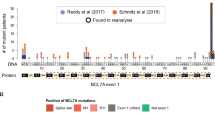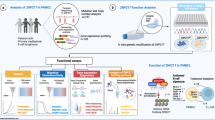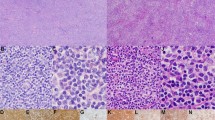Abstract
The suppressors of cytokine signaling (SOCS) are critically involved in the regulation of cellular proliferation, survival, and apoptosis via cytokine-induced JAK/STAT signaling. SOCS-1 silencing by aberrant DNA methylation contributes to oncogenesis in various B-cell neoplasias and carcinomas. Recently, we showed an alternative loss of SOCS-1 function due to deleterious SOCS-1 mutations in a major subset of primary mediastinal B-cell lymphoma (PMBL) and in the PMBL line MedB-1, and a biallelic SOCS-1 deletion in PMBL line Karpas1106P. For both cell lines our previous data demonstrated retarded JAK2 degradation and sustained phospho-JAK2 action leading to enhanced DNA binding of phospho-STAT5. Here, we analysed SOCS-1 in laser-microdissected Hodgkin and Reed-Sternberg (HRS) cells of classical Hodgkin lymphoma (cHL). We detected SOCS-1 mutations in HRS cells of eight of 19 cHL samples and in three of five Hodgkin lymphoma (HL)-derived cell lines by sequencing analysis. Moreover, we found a significant association between mutated SOCS-1 of isolated HRS cells and nuclear phospho-STAT5 accumulation in HRS cells of cHL tumor tissue (P<0.01). Collectively, these findings support the concept that PMBL and cHL share many overlapping features, and that defective tumor suppressor gene SOCS-1 triggers an oncogenic pathway operative in both lymphomas.
This is a preview of subscription content, access via your institution
Access options
Subscribe to this journal
Receive 50 print issues and online access
$259.00 per year
only $5.18 per issue
Buy this article
- Purchase on Springer Link
- Instant access to full article PDF
Prices may be subject to local taxes which are calculated during checkout




Similar content being viewed by others
References
Barth TF, Leithäuser F, Joos S, Bentz M, Möller P . (2002). Lancet Oncol 3: 229–234.
Barth TF, Martin-Subero JI, Joos S, Menz CK, Hasel C, Mechtersheimer G et al. (2003). Blood 101: 3681–3686.
Chen CY, Tsay W, Tang JL, Shen HL, Lin SW, Huang SY et al. (2003). Genes Chrom Cancer 37: 300–305.
Chim CS, Fung TK, Cheung WC, Liang R, Kwong YL . (2004a). Blood 103: 4630–4635.
Chim CS, Wong KY, Loong F, Srivastava G . (2004b). Leukemia 18: 356–358.
Endo TA, Masuhara M, Yokouchi M, Suzuki R, Sakamoto H, Mitsui K et al. (1997). Nature 387: 921–924.
Galm O, Yoshikawa H, Esteller M, Osieka R, Herman JG . (2003). Blood 101: 2784–2788.
Guiter C, Dusanter-Fourt I, Copie-Bergman C, Boulland ML, Le Gouvello S, Gaulard P et al. (2004). Blood 104: 543–549.
Hilton DJ, Richardson RT, Alexander WS, Viney EM, Willson TA, Sprigg NS et al. (1998). Proc Natl Acad Sci USA 95: 114–119.
James C, Ugo V, Le Couedic JP, Staerk J, Delhommeau F, Lacout C et al. (2005). Nature 434: 1144–1148.
Joos S, Granzow M, Holtgreve-Grez H, Siebert R, Harder L, Martin-Subero JL et al. (2003). Int J Cancer 103: 489–495.
Joos S, Otano-Joos MI, Ziegler S, Brüderlein S, du Manoir S, Bentz M et al. (1996). Blood 87: 1571–1578.
Komazaki T, Nagai H, Emi M, Terada Y, Yabe A, Jin E et al. (2004). Jpn J Clin Oncol 34: 191–194.
Kralovics R, Passamonti F, Buser AS, Teo SS, Tiedt R, Passweg JR et al. (2005). N Engl J Med 352: 1744–1746.
Krebs DL, Hilton DJ . (2001). Stem Cells 19: 378–387.
Kube D, Holtick U, Vockerodt M, Ahmadi T, Haier B, Behrmann I et al. (2001). Blood 98: 762–770.
Melzner I, Bucur AJ, Brüderlein S, Dorsch K, Hasel C, Barth TF et al. (2005). Blood 105: 2535–2542.
Melzner I, Weniger MA, Bucur AJ, Brüderlein S, Dorsch K, Hasel C et al. (2006). Int J Cancer 118: 1941–1944.
Ritz O, Leithäuser F, Hasel C, Brüderlein S, Ushmorov A, Möller P et al. (2005). J Pathol 205: 336–348.
Rosenwald A, Wright G, Leroy K, Yu X, Gaulard P, Gascoyne RD et al. (2003). J Exp Med 198: 851–862.
Rottapel R, Ilangumaran S, Neale C, La Rose J, Ho JM, Nguyen MH et al. (2002). Oncogene 21: 4351–4362.
Savage KJ, Monti S, Kutok JL, Cattoretti G, Neuberg D, De Leval L et al. (2003). Blood 102: 3871–3879.
Skinnider BF, Elia AJ, Gascoyne RD, Patterson B, Trumper L, Kapp U et al. (2002). Blood 99: 618–626.
Sutherland KD, Lindeman GJ, Choong DY, Wittlin S, Brentzell L, Phillips W et al. (2004). Oncogene 23: 7726–7733.
Yoshikawa H, Matsubara K, Qian GS, Jackson P, Groopman JD, Manning JE et al. (2001). Nat Gen 28: 29–35.
Acknowledgements
We thank Michaela Buck for excellent technical assistance. This work was supported by a grant of the Deutsche Krebshilfe, Mildred Scheel Stiftung (Grant number 106367) to TFE Barth and P Möller.
Author information
Authors and Affiliations
Corresponding author
Rights and permissions
About this article
Cite this article
Weniger, M., Melzner, I., Menz, C. et al. Mutations of the tumor suppressor gene SOCS-1 in classical Hodgkin lymphoma are frequent and associated with nuclear phospho-STAT5 accumulation. Oncogene 25, 2679–2684 (2006). https://doi.org/10.1038/sj.onc.1209151
Received:
Revised:
Accepted:
Published:
Issue Date:
DOI: https://doi.org/10.1038/sj.onc.1209151
Keywords
This article is cited by
-
Histone methyltransferase KMT2D inhibits ENKTL carcinogenesis by epigenetically activating SGK1 and SOCS1
Genes & Genomics (2024)
-
Molecular biology of Hodgkin lymphoma
Leukemia (2021)
-
Genomic analyses of microdissected Hodgkin and Reed-Sternberg cells: mutations in epigenetic regulators and p53 are frequent in refractory classic Hodgkin lymphoma
Blood Cancer Journal (2019)



